
A supernova is a powerful and luminous explosion of a star. A supernova occurs during the last evolutionary stages of a massive star or when a white dwarf is triggered into runaway nuclear fusion. The original object, called the progenitor, either collapses to a neutron star or black hole, or is completely destroyed to form a diffuse nebula. The peak optical luminosity of a supernova can be comparable to that of an entire galaxy before fading over several weeks or months.
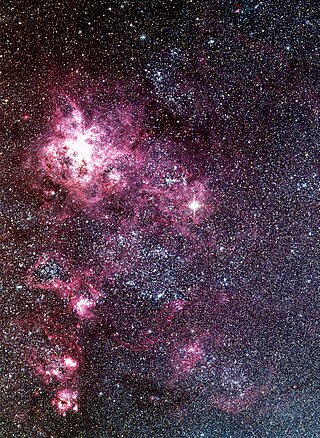
SN 1987A was a type II supernova in the Large Magellanic Cloud, a dwarf satellite galaxy of the Milky Way. It occurred approximately 51.4 kiloparsecs from Earth and was the closest observed supernova since Kepler's Supernova. 1987A's light reached Earth on February 23, 1987, and as the earliest supernova discovered that year, was labeled "1987A". Its brightness peaked in May, with an apparent magnitude of about 3.

The Whirlpool Galaxy, also known as Messier 51a (M51a) or NGC 5194, is an interacting grand-design spiral galaxy with a Seyfert 2 active galactic nucleus. It lies in the constellation Canes Venatici, and was the first galaxy to be classified as a spiral galaxy. It is between 23 and 31 million light-years away and 76,900 ly (23,580 pc) in diameter.

SN 2004dj was the brightest supernova since SN 1987A at the time of its discovery.

NGC 3184, the Little Pinwheel Galaxy, is a spiral galaxy approximately 40 million light-years away in the constellation Ursa Major. It has two HII regions named NGC 3180 and NGC 3181.

NGC 6946, sometimes referred to as the Fireworks Galaxy, is a face-on intermediate spiral galaxy with a small bright nucleus, whose location in the sky straddles the boundary between the northern constellations of Cepheus and Cygnus. Its distance from Earth is about 25.2 million light-years or 7.72 megaparsecs, similar to the distance of M101 in the constellation Ursa Major. Both were once considered to be part of the Local Group, but are now known to be among the dozen bright spiral galaxies near the Milky Way but beyond the confines of the Local Group. NGC 6946 lies within the Virgo Supercluster.
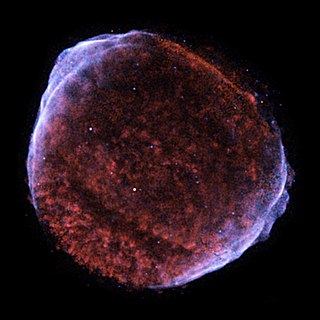
SN 1006 was a supernova that is likely the brightest observed stellar event in recorded history, reaching an estimated −7.5 visual magnitude, and exceeding roughly sixteen times the brightness of Venus. Appearing between April 30 and May 1, 1006, in the constellation of Lupus, this "guest star" was described by observers across China, Japan, modern-day Iraq, Egypt, and Europe, and was possibly recorded in North American petroglyphs. Some reports state it was clearly visible in the daytime. Modern astronomers now consider its distance from Earth to be about 7,200 light-years or 2,200 parsecs.

SN 1998bw was a rare broad-lined Type Ic gamma ray burst supernova detected on 26 April 1998 in the ESO 184-G82 spiral galaxy, which some astronomers believe may be an example of a collapsar (hypernova). The supernova has been linked to GRB 980425, which was detected on 25 April 1998, the first time a gamma-ray burst has been linked to a supernova. The supernova is approximately 140 million light years away, very close for a gamma ray burst source.
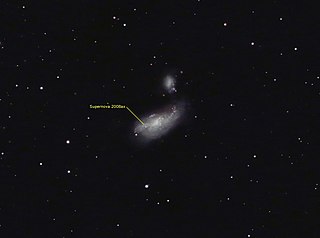
SN 2008ax was a helium-rich type Ib core-collapse supernova in the interacting galaxy NGC 4490. It was independently discovered on 3 March 2008 by LOSS and 4 March by Koichi Itagaki. The site had been monitored six hours before discovery, thus constraining the time of the explosion breakout. It was the third-brightest supernova of 2008. The brightness in the B-band peaked about 20 days after the explosion. X-ray emissions were detected from the event, which are most likely the result of shock heating from the supernova ejecta and circumstellar material.

NGC 7424 is a barred spiral galaxy located 37.5 million light-years away in the southern constellation Grus. Its size makes it similar to our own galaxy, the Milky Way. It is called a "grand design" galaxy because of its well defined spiral arms. Two supernovae and two ultraluminous X-ray sources have been discovered in NGC 7424.

Supernova impostors are stellar explosions that appear at first to be a supernova but do not destroy their progenitor stars. As such, they are a class of extra-powerful novae. They are also known as Type V supernovae, Eta Carinae analogs, and giant eruptions of luminous blue variables (LBV).

SN 1994I is a Type Ic supernova discovered on April 2, 1994 in the Whirlpool Galaxy by amateur astronomers Tim Puckett and Jerry Armstrong of the Atlanta Astronomy Club. Type Ic supernova are a rare type of supernova that result from the explosion of a very massive star that has shed its outer layers of hydrogen and helium. The explosion results in a highly luminous burst of radiation that then dims over the course of weeks or months. SN 1994I was a relatively nearby supernova, and provided an important addition to the then small collection of known Type Ic supernova. Very early images were captured of SN 1994I, as two high school students in Oil City, Pennsylvania serendipitously took images of the Whirlpool Galaxy using the 30-inch telescope at Leuschner Observatory on March 31, 1994, which included SN 1994I just after it began to brighten.
SN 2011dh was a supernova in the Whirlpool Galaxy (M51). It was discovered on 31 May 2011, with an apparent magnitude 13.5. and confirmed by several sources, including the Palomar Transient Factory. A candidate progenitor was detected in Hubble Space Telescope images. The progenitor may have been a highly luminous yellow supergiant with an initial mass of 18-24 solar masses. The supernova peaked near apparent magnitude 12.1 on 19 June 2011. Emission spectra indicated that the explosion was a type II supernova, in which a massive star collapses once nuclear fusion has ceased in its core.
SN 1961V was an abnormal, supernova-like event that was a potential supernova impostor. The potential impostor nature of SN 1961V was first identified by Fritz Zwicky in 1964. SN 1961V occurred in galaxy NGC 1058, about 9.3 Mpc away. Unlike many supernovae, the progenitor star is tentatively known: an extremely large, very bright blue star, similar to Eta Carinae. Mass estimates of the precursor star were as high as 2000 times the mass of the sun, but these are likely to be extreme overestimates. If SN 1961V was not a supernova then it was most likely an extremely large outburst by a luminous blue variable star.
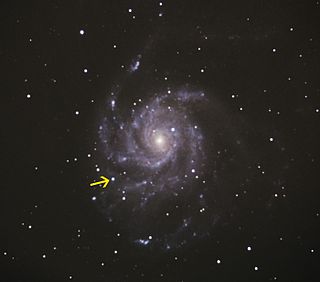
SN 2011fe, initially designated PTF 11kly, was a Type Ia supernova discovered by the Palomar Transient Factory (PTF) survey on 24 August 2011 during an automated review of images of the Messier 101 from the nights of 22 and 23 August 2011. It was located in Messier 101, the Pinwheel Galaxy, 21 million light years from Earth. It was observed by the PTF survey very near the beginning of its supernova event, when it was approximately 1 million times too dim to be visible to the naked eye. It is the youngest type Ia ever discovered. About 13 September 2011, it reached its maximum brightness of apparent magnitude +9.9 which equals an absolute magnitude of about -19, equal to 2.5 billion Suns. At +10 apparent magnitude around 5 September, SN 2011fe was visible in small telescopes. As of 30 September the supernova was at +11 apparent magnitude in the early evening sky after sunset above the northwest horizon. It had dropped to +13.7 as of 26 November 2011.

NGC 5806 is an intermediate spiral galaxy in the constellation Virgo. It was discovered on February 24, 1786, by the astronomer John Herschel. It is located about 70 million light-years away from the Milky Way. It is a member of the NGC 5846 Group.

NGC 3938 is an unbarred spiral galaxy in the Ursa Major constellation. It was discovered on 6 February 1788 by William Herschel. It is one of the brightest spiral galaxies in the Ursa Major South galaxy group and is roughly 67,000 light years in diameter. It is approximately 43 million light years away from Earth. NGC 3938 is classified as type Sc under the Hubble sequence, a loosely wound spiral galaxy with a smaller and dimmer bulge. The spiral arms of the galaxy contain many areas of ionized atomic hydrogen gas, more so towards the center.

UGC 4904 is a barred spiral galaxy in the constellation Lynx, located about 77 million light-years from Earth. On October 20, 2004, a supernova impostor was observed by Japanese amateur astronomer Koichi Itagaki within the galaxy. This same star may have transitioned from a LBV star to a Wolf–Rayet star shortly before it was observed as blowing up as hypernova SN 2006jc on October 11, 2006.

SN 2014J was a type-Ia supernova in Messier 82 discovered in mid-January 2014. It was the closest type-Ia supernova discovered for 42 years, and no subsequent supernova has been closer as of 2023. The supernova was discovered by chance during an undergraduate teaching session at the University of London Observatory. It peaked on 31 January 2014, reaching an apparent magnitude of 10.5. SN 2014J was the subject of an intense observing campaign by professional astronomers and was bright enough to be seen by amateur astronomers.
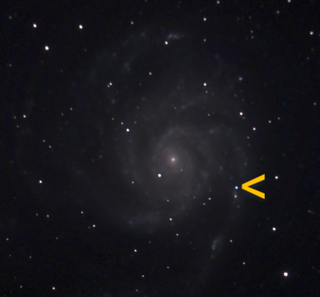
SN 2023ixf is a type II-L supernova located in the Pinwheel Galaxy (M101). It was first observed on 19 May 2023 by Kōichi Itagaki and immediately classified as a type II supernova. Initial magnitude at discovery was 14.9. After discovery, the Zwicky Transient Facility project found a precovery image of the supernova at magnitude 15.87 two days before discovery. The supernova is about 21 million light-years from Earth and is expected to have left behind either a neutron star or black hole based on current stellar evolution models.




















